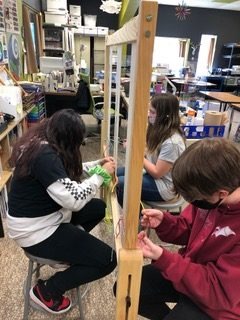This summer, at a conference, Amy O’Hara listened to executives at regional engineering firms and scientific labs discuss the critical skills they seek in new hires. Without exception, they look for the ability to think creatively, generate ideas, and think outside the box. “This only served to validate my belief that art is imperative,” said Amy, art teacher at Forrest Bird Charter School.
Amy has been the recipient of several PAFE grants over the years. She looks to PAFE to enhance her program and fill in the gaps where the school budget falls short. For example, her budget covers consumables like paper, paint, and scissors. Still, thanks to PAFE, she has created a working studio with a printing press, ceramics equipment, an innovative curriculum called Visual Thinking Strategies (more on that in the future!), and now, a loom to introduce weaving and fiber arts.
When awarding grants, PAFE is interested in programs that help more students over an extended period. The Friendly Loom was a perfect fit for us. First of all, we respect the work Amy is doing, and secondly, we love that the loom gets used consistently. It’s a collaborative stand-up loom that up to six weavers can use together. One that reaches more and more students every year. Because of its mobility, she also takes it to family events and instantly has an interactive and collaborative art installation.
Weaving is one of the first crafts humans have performed. Early in civilization, nets were woven for fishing, reeds for baskets, and eventually textiles for clothing. Every culture has a tradition of weaving.
Said Amy: “It can be frustrating for a student who can’t draw something. But weaving isn’t like that. It is a very forgiving art. One works in patterns, and it becomes meditative and restful.”
Choice-Based Art and Why it Matters
As a choice-based art teacher, Amy focuses on artistic thinking through centers of art-making. “I give them the space, show them how to operate it, and they work where they want from painting and drawing to printing and weaving. Different learners thrive in different environments, and this space accommodates that.”
Her philosophy makes all of us want to start over and make art again.
“Art is process-based. It isn’t always about the end product. When they come into the classroom, I hope students chill out and get lost in their work. You don’t have to be making something. The work happens in the mucking around. The learning happens in the making.”
Amy argues that art should be a core discipline in the curriculum. It develops cognitive functioning and creative thinking. But art is woefully underrated and underfunded in favor of academics. Side note: The executives at the conference this summer confirmed this perspective.
If you think about it, an artist or designer touched everything we wear and drive and consume.
“Students come to me, and they can’t handle failure. They can’t muscle through things. Not everyone is going to be an artist. I want to see them leave my classroom as creative thinkers and problem-solvers.
By supporting The Friendly Loom project, PAFE has given me the tools to enrich my students’ education with a time honored and culturally significant art form, quality tools and opportunities for collaborative art making. The Friendly Loom has become an indispensable part of our choice-based art room.”
Interested in supporting this work? Donate here to support these and other classroom initiatives that help teachers build out their arts, science, technology, engineering, and math programs.
